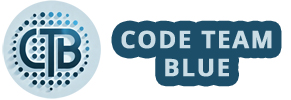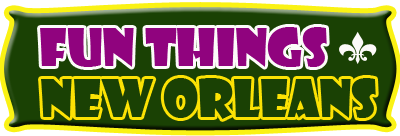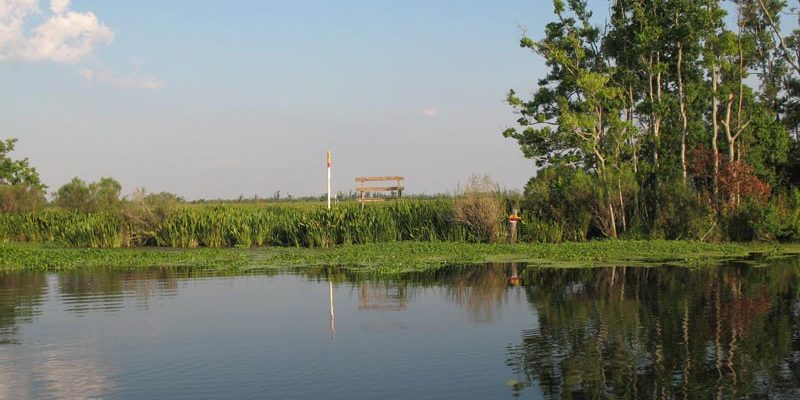The swamps and bayou’s that surround the New Orleans area are one of the greatest outdoor sanctuaries in the world. Known as The Sportsman’s Paradise, it should be near the top of your list of places to visit while in the Big Easy. The main attractons are swamp tours for those of you that are not into hunting a fishing the swamp tours and gator farms.
Swamp Tours
Swamp tours are a great family adventure while on vacation in the Big Easy. Most of them take about 4 hours door to door and buses leave from Downtown/The French Quarter. Many companies will provide combo trips with either a plantation tour or a walking tour of the French Quarter. It is best to go on a nice day. If it is raining too hard, most of the tours will be canceled. Pricing is cheaper for kids and drive-ups at most companies. There are two basic types of tours, Airboat tours and ones on less aggresive ponton like boats.
Fishing in the New Orleans Bayou
The fishing outside of New Orleans is some of the best in the world. Trips are about $300-$500 for a group. The only down-side is that the weather, wind, and tide all have to be good or the trip will be a bust. The time of year doesn’t matter here as much as it does in other places, but the day-to-day conditions have a big impact on fishing. The reason for this is that the water is so muddy that when it gets ‘dirty’ the fish just don’t bite.
Gator Hunting near New Orleans
The Gator Season is during the month of September and is highly regulated. You must have a permit (and typically you must have right to land to get a permit), to harvest a gator. While you get to kill your gator with the weapon of your choice, there is a catch. The camp will catch the gator first on a huge meat hook with half a chicken, much like fishing. They hang the hook on a tree branch about 2 feet over the water and the gator then goes up for the chicken and gets hooked. Then you drive up in the morning and kill the hooked gator. So harvesting your gator is even less sporty than a ‘European Hunt.’ Trips run about $1000 – $4000.
Gator Farms
Just outside of New Orleans you can visit a gator farm full of live alligators. There is on just ouside the city on West Bank, and one about 50 miles away a little past the north shore. Links at the bottom of the page.
Duck Hunting
The surrounding areas just outside of New Orleans are one of the preimer destination for duck hunting in the world. The weather compared to other duck hunts can be very mild and plesant during the winter. One of the main reasons the ducks are down here for the season.
Local Websites
Swamp Tours
Gator Farms
Gator Hunting
50% off a small business website if you mention
this post and how you found it.
- Basic small business website, norml price $500, your price $250
- E-brocer Deliux Websites $1000 off custom bid packages of $2000+
- $2000 Off Coding Projects of $10K+
Visit Code Team Blue for more information

What is the difference between a bayou, swamp and a marsh?
A bayou is a slow-moving or stagnant body of water, like a creek or small river, usually found in flat, low-lying areas.
Key Features:
- Can be freshwater, brackish, or saltwater.
- Often connected to larger rivers or lakes.
- Surrounded by marshes or swamps.
- Water is always present, but flow is very slow.
Where in Louisiana:
- Common around the Mississippi River Delta and Gulf Coast.
- Famous bayous include Bayou Lafourche, Bayou Teche, and Bayou St. John.
Typical Wildlife:
- Fish, alligators, snakes, herons, turtles.
2. Marsh
Definition:
A marsh is a wetland dominated by grasses, reeds, and herbaceous (non-woody) plants.
Key Features:
- Few or no trees.
- Soil is often waterlogged or flooded.
- Can be freshwater or saltwater (like coastal marshes).
- Very important for bird habitats and coastal protection.
Where in Louisiana:
- Found along the Gulf Coast, particularly in Cameron Parish and the Atchafalaya Basin.
Typical Wildlife:
- Ducks, geese, shorebirds, frogs, muskrats, nutria.
3. Swamp
Definition:
A swamp is a forested wetland, meaning it has lots of trees growing in standing or slow-moving water.
Key Features:
- Trees and shrubs dominate, especially bald cypress and tupelo.
- Usually freshwater.
- Water can be shallow or deep, and may be seasonal.
- More closed-in and shaded than a marsh.
Where in Louisiana:
- Atchafalaya Swamp, Honey Island Swamp, Manchac Swamp.
Typical Wildlife:
- Alligators, turtles, owls, snakes, raccoons, fish, and insects.
Interesting Facts
- Louisiana has 25% of the U.S.’s wetlands, but loses around a football field of land every 100 minutes due to erosion and sea level rise.
- The Honey Island Swamp is one of the most pristine swamps in the U.S. and rumored to be home to a Bigfoot-like creature.
- The Atchafalaya Basin is the largest river swamp in the U.S.—larger than the Florida Everglades.
What is a Nutria?
nutria, also known as a coypu, is a large, semi-aquatic rodent originally from South America that has become invasive in Louisiana and other parts of the U.S. Louisiana has a Coastwide Nutria Control Program that pays hunters a bounty for each tail turned in. Over 5 million nutria have been removed since the program started in 2002.

